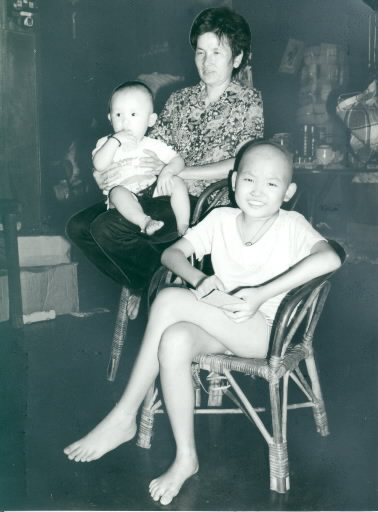4. A High Incidence of Leukemia in Bukit Merah
Feb. 27, 2013
Chapter 4: India, Malaysia, Korea
Part 2: Thorium Contamination in Malaysia
Part 2: Thorium Contamination in Malaysia
Just over five hundred yards from the site of the ARE refinery, we entered a house to find ourselves in a living room lit by a 15-watt fluorescent light that allowed us to make out piles of cardboard boxes heaped haphazardly on top of one another. A child appeared from another room, calling out "Hello!" Her radiant smile and cheerful tone seemed to light up the house, and we shook hands with pleasure. Lam Lai Kuan was eleven years old, and in sixth grade. She was completely bald, and for a second we mistook her for a boy, until we spotted the necklace and anklet she was wearing. In January of that year (1989), she had been diagnosed as having acute lymphatic leukemia. She had lost all her hair as a result of the radiation therapy.
"I started getting a sore back in November last year—it got worse and worse till I couldn't walk anymore." After she had seen the doctor in Bukit Merah, the girl was sent to Ipoh General Hospital, where she was treated for three and a half months. Her condition improved, and she was able to return to school, although continuing to make frequent visits to the hospital. However, the symptoms appeared once again, and from August till October of 1989 she was hospitalized in Kuala Lumpur. "We've only just got back," called out her mother, Hiew Chao Thye, from where she was sitting bouncing her first grandchild on her knees. She looked very tired, as if worry about her daughter's health was taking its toll.
Lai Kuan herself found out she had leukemia during her second spell in hospital. "The doctors said it was a difficult disease to cure, but because they found out about it early they said it'd be alright." There was not a hint of worry in her voice. "Everyone asks me why all my hair has fallen out," she said. "Some of my friends ran away when I told them it was because of radiation." She is the youngest of three daughters. Her father died in an accident at work when she was three. "I want to become a teacher when I grow up," she told us. Her mother made no comment.
We left Lam Lai Kuan's home and walked a few yards to our next stop, the home of Koh Poo Onn, another leukemia patient.
Koh was nineteen years old, but the disease had aged him beyond his years; his body was emaciated, his complexion a sickly white. The youth had been sent to Ipoh General Hospital with jaundice in October 1988, where it was discovered that he had leukemia. He had just started work at a small shoe factory in Bukit Merah.
"It was a real shock when I found out that I had leukemia. I blamed myself, trying to think what I could have done to cause it." Koh still goes to the hospital once a week for treatment. His back gives him trouble, making it impossible for him to get a proper job because he cannot work for long periods. When he is feeling well enough he helps a friend to make shoes.
"The doctor told me that it would be better for me to move away from Bukit Merah because my resistance has been lowered by the loss of so many white blood cells... but I don't have the money to leave."
There was one more leukemia patient in the village, a five-year-old boy whose home was a mere hundred yards from the ARE complex. He was in the University Hospital of Kuala Lumpur when we visited Bukit Merah.
Three leukemia cases had been diagnosed within a year in this town of seven thousand. In the previous five years there had been none. Malaysia's annual rate of leukemia is three cases per one hundred thousand people, making the incidence of leukemia in Bukit Merah fourteen times higher than the national average.
Although difficult to prove, it would seem likely that the high incidence of leukemia was caused by thorium contamination from ARE.
"Getting compensation won't improve our health—what we really need is for that place to close as soon as possible," concluded Koh.








